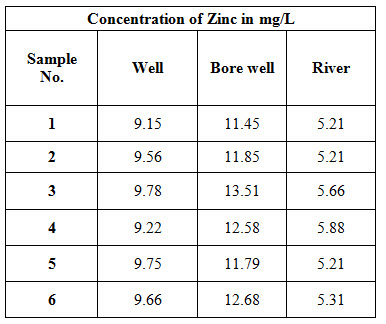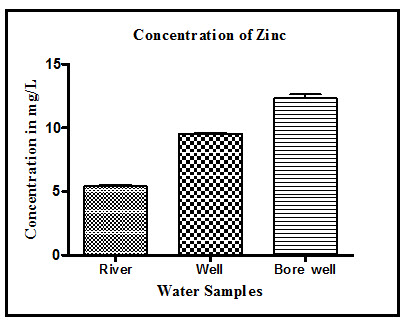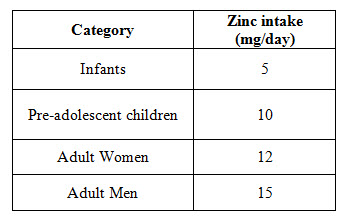{ DOWNLOAD AS PDF }
ABOUT AUTHORS
Sanjay A. Nagdev*1, Mayur R. Bhurat1 and Krishna R. Gupta2
1 K.Y.D.S.C.T’s College of Pharmacy, Sakegaon-Bhusawal, Maharashtra
2 Smt. Kishoritai Bhoyar college of Pharmacy, Kamptee, Maharashtra
*snsanjurocks@gmail.com
ABSTARCT
The Present study was designed for the estimation of essential trace element Zinc in drinking water from natural sources like well, bore-well and river of Bhusawal (Maharashtra) (21.0455° N, 75.8011° E).Samples were evaluated as per Bureau of Indian standards 10500 for Zinc, Concentration of Zinc in water samples of River, well and Bore well was found within the safe limits of World Health Organization guidelines for zinc and also study finding suggest that bore well is the better and rich source of Zinc as compared to Well and river and population residing in the region and consuming water from bore well would be less prone to Zinc deficiency as compared to Population consuming water from other sources like well and river.
[adsense:336x280:8701650588]
Reference Id: PHARMATUTOR-ART-2583
|
PharmaTutor (Print-ISSN: 2394 - 6679; e-ISSN: 2347 - 7881) Volume 6, Issue 5 Received On: 06/03/2018; Accepted On: 19/03/2018; Published On: 01/05/2018 How to cite this article: Nagdev SA, Bhurat MR, Gupta KR; Health risk assessment to Zinc in Drinking Water of rural residents living in Bhusawal city, Maharashtra (India); PharmaTutor; 2018; 6(5); 48-50; http://dx.doi.org/10.29161/PT.v6.i5.2018.48 |
INTRODUCTION
Zinc is an essential trace element, which is needed by human body to regulate the production of enzymes because zinc is utilized by 100 different enzymes that are involved in the chemical processes of building things that the body needs like to make thyroid stimulating hormone, calcitonin, production of collagen, for first line defense of body (immunity) and also zinc is essential to prevent zinc deficiency(Underwood EJ.,1971), and diarrhea in pediatrics (Bajait C et al., 2011). Hence the overall objective of the present study is to quantitatively estimate the amount of essential trace element Zinc in the drinking water to ensure the required and safe levels of Zinc in drinking water to fulfill the daily requirement of body as per Bureau of Indian Standards Specification from different Natural sources such as river, well and bore well (Zinc in Drinking water., 1993).
MATERIALS AND METHODS
COLLECTION OF WATER SAMPLES
Different sources such as river, well and bore well of Bhusawal (21.0455° N, 75.8011° E) region was selected for study. Water samples were collected with utmost care to ensure that no contamination occurs at the time of collection or prior to examination. Closure was removed with care to avoid contamination and held near base filled with water without rinsing and closed immediately. Plastic bottles of 1Litre capacity were used for trace element determination, washed with nitric acid (3%) rinsed three times with distilled water, dried and filled with water leaving no air space and tightly closed with plastic closures to prevent any leakage. Each container was clearly marked with name and date of sampling.
Sampling from well and bore-well: To the discharge tap of mechanical pump fitted to well or bore-well, rectified spirit was applied and allowed to dry before collection of sample, Water was pumped to waste for four to five minutes and then flow was restricted to permit filling the bottle without splashing.
Sampling from river: Areas of relative stagnation in a stream were avoided. For collection of water sample from river bottles was hold in hand near base and plunging its neck downward below the surface and turned until the neck points slightly upward, the mouth being directed against the current.
EVALUATION OF WATER SAMPLES
Evaluation of water samples was carried out as per Bureau of Indian Standard 10500 for safe water quality parameter of Zinc (Drinking water specification Indian Standards 10500:2012).
RESULTS
Concentration of Zinc in all water samples were found within the safe limits of World Health Organization guidelines and Concentration of Zinc was found high in water samples of bore well of Bhusawal (21.0455° N, 75.8011° E) region.
Table No.1: Concentration of Zinc content in water samples of well, bore-well and river of Bhusawal region


Figure no. 1 Concentration of Zinc in Water samples of River, Well and Bore-well of Bhusawal region
NOW YOU CAN ALSO PUBLISH YOUR ARTICLE ONLINE.
SUBMIT YOUR ARTICLE/PROJECT AT editor-in-chief@pharmatutor.org
Subscribe to Pharmatutor Alerts by Email
FIND OUT MORE ARTICLES AT OUR DATABASE
DISCUSSION
In context to human health these trace elements are important and inadequate daily consumption can impair health, these can be fulfilled by parallel consumption of water. Zinc plays important role in first line defense (Immunity), taste sensation, secretion of gastric enzymes and wound healing. Zinc is essential for proper growth, normal spermatogenesis, wound healing, taste sensation and secretion of gastric enzymes and inadequate Zinc intake is associated with retardation of growth in children, coronary artery disease, poor wound healing, high blood cholesterol, low blood sugar level and diarrhea in pediatrics (Lingamaneni P et al., 2015). The acceptable safe limits of Zinc content in drinking water according to World Health Organization is 5-15 mg/L (World Health Organization Guidelines for Drinking Water Quality, 1993).
Table no. 2: List of adequate intake of Zinc in different group of population

Daily requirement of zinc varies in different age groups from 5 to 15 mg/day (Prasad A et al., 2013). As food is a primary source but adequate intake can be fulfilled by parallel consumption of water.
CONCLUSION
Quantitative estimation of Zinc in water samples from Natural sources Of Bhusawal (21.0455° N, 75.8011° E) region showed that concentration of zinc is within acceptable safe limits as per WHO guidelines of Zinc and Concentration of Zinc Was Found High in water samples of Bore well as compared to well and river, therefore from the study it can be suggested that Population residing in Bhusawal region consuming water from Bore well are getting more Zinc as compared to Population Consuming water from Well and river and Population Consuming water from Bore well will be less prone to Zinc deficiency and other diseases associated with Zinc deficiency.
REFRENCES
1. Underwood, EJ. (1971); Trace elements in human and animal nutrition; Academic Press, New York.
2. Bajait C and Thawani V (2011); Role of zinc in pediatric diarrhea; Indian J Pharmacol; 43(3); 232–235.
3. Zinc in Drinking water (1993); Background document for development of World Health Organization Guidelines for Drinking water Quality.
4. Bureau of Indian Standard Drinking Water-Specification (2012); Indian Standards 10500:2012.
5. Lingamaneni P and Chitturi P (2015); a review on role of essential trace elements in health and disease; Journal of Dr. NTR University of Health Sciences; 4(2); 75-85
6. Guidelines for Drinking Water Quality (1993); World Health Organization; Second Edition-Volume-1, Geneva.
7. Prasad A (2013); Discovery of Human Zinc Deficiency: It’s Impact on Human Health and Disease; American society for nutrition; Adv nutria; (4); 176-190
NOW YOU CAN ALSO PUBLISH YOUR ARTICLE ONLINE.
SUBMIT YOUR ARTICLE/PROJECT AT editor-in-chief@pharmatutor.org
Subscribe to Pharmatutor Alerts by Email
FIND OUT MORE ARTICLES AT OUR DATABASE









